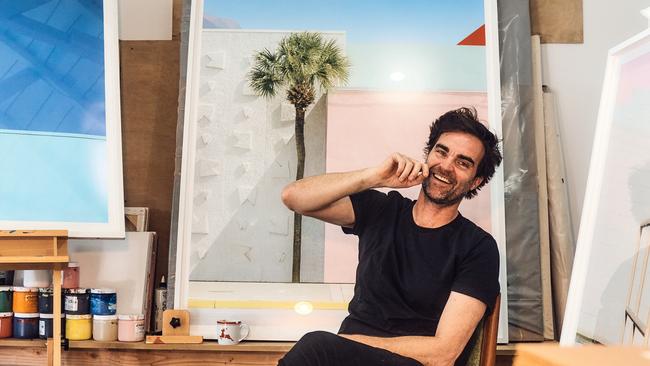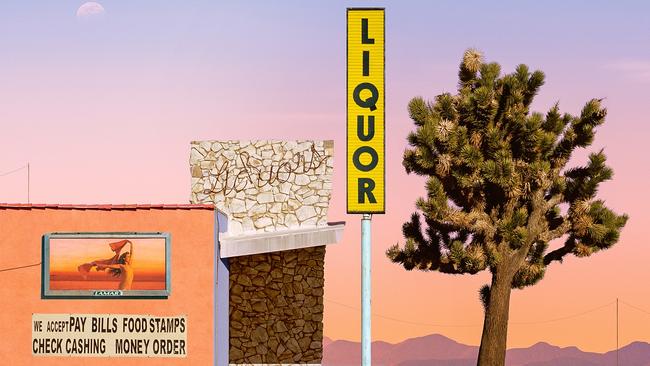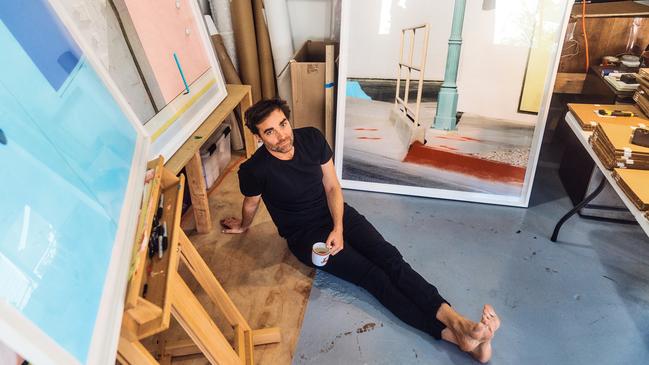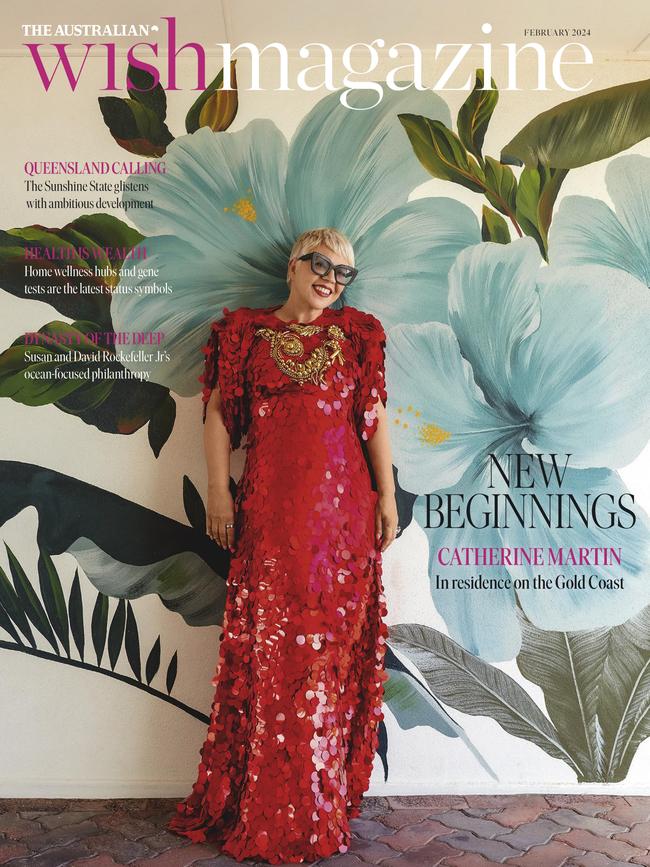George Byrne used to take photos; now he makes them
Meet the LA-based Australian photographer embracing the creative world of AI.

As a kid George Byrne was a bit of a dreamer. He always knew he’d become an artist. Well, at least eventually.
“I was head-out-the-window, looking at the clouds, and it’s funny, thinking back, I was always thrilled by visuals. Visual sensibility was strong in my brain from very young,” Byrne says. “I guess that’s why photography was an immediate match. But I was always into creative stuff. I was into painting and loved music and sport. And then I was lucky enough to have supportive parents who were always encouraging of whatever I wanted to explore. I think that’s why I ended up heading into the arts.

“I was just like, ‘What do I feel best at and what am I most natural at?’. And that’s sort of how I ended up sticking with it. But it wasn’t until I was in my late thirties that I was doing it for a living. There were many years of a lot of other things.”
An abridged list of those many things Byrne – the older brother of actor Rose Byrne – did before becoming a full-time artist includes playing in a band, bar work, a baker’s assistant, driving people to their chemotherapy appointments, and bricklaying.
All of it added up to where he is now. This month he is home in Australia to stage a new exhibition of his work, Synthetica, at Olsen in Sydney. It is the same gallery that gave Byrne his first big opportunity in 2015. He met Tim Olsen through their mutual friend, the artist Paul Davies, in Los Angeles, where Byrne has lived for the past 10 years. He says watching the gallerist at work is like “watching a master of any trade”.
“In the realm of contemporary photography, George emerges as a compelling figure whose lens speaks a universally understood visual language, resonating not only within the photographic community but also echoing through the corridors of the broader art world,” says Olsen of Byrne’s deft exploration of urban landscapes, whether domestic or industrial, challenging our predisposed perceptions of the ordinary.
Byrne says his first exhibition at Olsen changed everything. “It elevated what I was doing to a new scale physically, the works became big, which is what the initial plan was, five by six feet scale. And also they’re such an incredible gallery, their pedigree, that just being there elevates you to a whole other level. You’re exposed to other people, you’re exposed to museums, you are exposed to different collectors. So that really forced me to elevate my own process as well and get better at what I was doing. But prior to that, I was doing it for a living, but it was on a very small scale. I was like a cottage industry doing my own little prints and exhibiting them in my friends’ shops.”
Building up an audience on social media who follow his work also gave him the confidence to pursue art full-time.

“I think as well as having all those experiences and stops and starts and failures and minor successes here and there, I think when I saw my opportunity emerging in photography five or six years ago, I was very ready to get serious. I knew that these opportunities very rarely come. And in a creative field, if you can see that you are really connecting with something that’s connecting with people equally, I was loving what I was doing and I was fully immersed and obsessed with it. And at the same time, I’m seeing that there’s this crowd of people following me and it was like, ‘Oh, OK, I’ve got to really do this properly’.”
Byrne started his creative practice very much in line with the new topographics photography movement, which emerged in the mid-’70s as a way of documenting the mundanities of urban life. Later he started experimenting with collage and post-production creative techniques to create pastel-dipped images of a Los Angeles that is, and isn’t, real. It’s been viewed as a love letter to his adopted city (which he says, is his constant “muse”) and to finding magic in the everyday. His work has attracted comparisons to everybody from filmmaker Wes Anderson to artists such as Edward Hopper and James Casebere.
The evolution of his work these past few years is a sign of his maturation as an artist and also his views on what photography can be.
“I guess the early origin of the work was very much raw street landscapes. I was coming off an interest in the new topographics photography movement that I studied at art school and that sort of investigating banal urban spaces. That was my interest from being in LA and I was shooting in colour and just recording things pretty straight. And the evolution, in a nutshell, was I just started to experiment from about 2016 and ’17 with various forms of collage and manipulation, very subtle at first because I didn’t know how to do it. It all happened very organically. I was sort of trying to fix something and then I accidentally moved something. I’m like, ‘Huh, so I can move things?’. Once I realised the photos were malleable, that unlocked a whole new way of thinking about taking photos. I was starting to make them rather than take them.”
Byrne’s work, the way he plays with the real and the unreal, comes at an interesting time. Like most of us, he too is fascinated by the possibilities of artificial intelligence (AI). He has played with several AI tools that can do such things as blend his work with that of Picasso’s. (What does it look like? “It just looks exactly what you would imagine … it’s just perfectly that.”)
But he’s still grappling with how, if at all, this new frontier might influence his work or way of thinking.

“I honestly named my new show Synthetica prior to the arrival of synthetic photography, which is what I’ve heard this AI movement is referred to. So, I’m sort of driving alongside it. I’m not convinced that AI is able to push the boundaries of creative perception, yet. I think it’s very good at amalgamating what’s already done,” Byrne says.
“But everything that I saw it do with my work, I just thought it gave me a little dopamine hit when I saw it. Then I thought, ‘You know what? I could do better’ … or not better, but it’s sort of like it’s just a bit back from where I’m going.”
One thing that Byrne is comfortable with is that the only real guarantee in life is that it will change. Earlier this year Byrne married New Zealand actor Rose McIver and in April the couple will welcome their first baby. It’s a girl, and the whole family – full of baby boys – is delighted.
“I have a lot of nephews and we have had a lot of little boys, so this will be the first baby girl. My family are all thrilled. We’re going to have the baby in LA and my parents are going to come over and spend some time with me, and my sister [Rose] is going to come over from New York and spend some time,” he says.
As for how fatherhood might impact his life of often being in different places, and constant creation, he’s excited to see it unfold. There is also the flutter of a pull back towards Australia.
“I always have been running a million miles an hour and loving travelling and getting a lot out of that, but I’m getting a little bit more homey. We got a dog. I’m starting to see that travelling doesn’t meld that well with those things. The dog doesn’t thrive from travelling, the baby’s not going to thrive. I’m going to be starting to see the benefits of a more static stage of life, and I’m looking forward to it, too,” he says.

“I think I’ll be back in Australia a lot more and I just want to explore Australia, too. I’ve spent my whole life going everywhere else … I want to travel the coastline of the whole country. I want to drive it and make a book out of it and start to point my work inward and experiment with other things. I’ve been dabbling with some painting lately, which has been really fun. Exactly where it’s all going, throw in a bit of AI, who knows what I’m going to be doing?”
This article appears in the February issue of WISH Magazine, out now.




